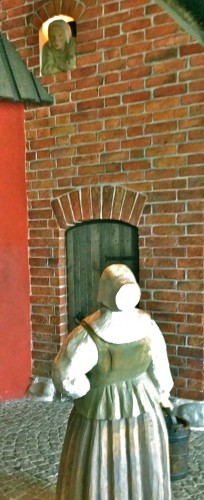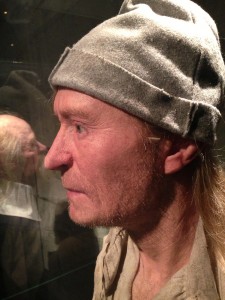How could it happen? Was it the wrath of God or the malice of Poland? Was the crew drunk or was the Vasa wrongly built? The town was alive with rumours.
I’ll bet it was. On August 10, 1628, the warship Vasa—the pride of Sweden, the talk of Stockholm—set sail on its maiden voyage. It didn’t even get out of the harbor. The Vasa plugged along for 1300 yards, or about 4/5 of a mile, and then ran smack into a viciously gentle breeze, after which it toppled over and sank.
Divers managed to salvage some cannons, but otherwise the Vasa lay at the bottom of the harbor until it was rediscovered in the 1950s and raised in 1961. To say that today it is the centerpiece of the Vasamuseet, a museum on the harbor in Stockholm, is an understatement. The ship—226 feet in length, 38 feet at its maximum width—certainly does dominate the vast modernist structure. But as I made my way around the museum this past August, I couldn’t help thinking that something was odd here. The experience was unlike any I’ve had in a museum. And then, as I stood before a life-size sculpture of two women talking, and as I read in the explanatory plaque on a nearby wall that the “town was alive with rumours,” I realized what distinguishes the museum.
It’s not that its subject is a ship. It’s that its subject is a thing.
Two days earlier I had visited the Museum of the History of Science, in Oxford. The collection skews toward scientific instruments, especially of the astronomical variety, but it does include many other disciplines and cover just about every era of discovery. I hadn’t known about the blackboard on which Einstein explained the general theory of relativity during a visit to Oxford in 1931, though I later learned from the internet that it’s the museum’s most popular exhibit. A pleasant surprise and, all in all, a pleasant hour.
Before visiting the Museum of the History of Science, I had stopped at the Ashmolean Museum of Art and Archeology, around the corner. Its collection, too, reflects many disciplines, many eras—or, as its website says, the “galleries are interlinked by one big theme, Crossing Cultures, Crossing Time.”
Each of those museums, I thought as I wandered beneath the hull of the Vasa, begins with a generalization: history of science; art and archeology. Then I realized that so do most museums: natural history; modern art; contemporary art; American art; national design; the penis; baseball.
But the Vasa Museum? It doesn’t begin with a generalization; it begins with a specific object. Most museums use a concept as the founding principle, and then rely on that concept to organize its things—its scientific instruments, its works of art. The Vasa takes the opposite approach. It uses a thing as its founding principle, and then uses that thing to introduce whatever concepts happen to apply: forensics, archeology, history, chemistry, microbiology, navigation, and, in the tableau of two women speculating on the cause of the disaster, sociology. (In fact, the ship was top-heavy, though the reference to Poland foreshadows an exhibit about the era’s military context.)
That trajectory, from the specific to the universal, is how narratives work. The artist—whether writer, composer, painter—tries to capture a very particular something (whatever that very particular something is) in a singular way. The artist’s job is to find the detail so specific—the telling gesture, a character’s twitch, the shade of twilight, a line of dialogue—that it will resonate with everyone. Because when the specific becomes visceral, it also becomes universal.
Museums that work the other way—from the universal to the specific—make the beginning storyteller’s mistake of starting with a theme. A creative writing student of mine a few years ago mentioned to me several times that he wanted to write a novel, and I encouraged him to give it a try. Eventually I realized I didn’t know what the novel was about. “Death,” he said. Okay, I said, but what’s the plot? And who are the characters? Oh, those, he said; he hadn’t worked them out yet. I advised him that rather than starting with a theme and then creating characters whom he can lead toward a pre-ordained catharsis, he should start with characters and see where they lead him.

You could build a museum around Einstein’s blackboard. It would begin there and then—an Oxford lecture hall on May 16, 1931—and it would go wherever the topic would lead it. It wouldn’t necessarily be a better museum than the Museum of the History of Science in Oxford, but it would be truer to the human experience.
The there-and-then of the Vasa Museum is Stockholm harbor on August 10, 1628. Which is just another way of saying—in terms of a narrative wherein two women who never existed try to make sense of the incomprehensible, wherein the visceral becomes universal—here and now.
Yes, the town was alive with rumors. But more to the point, it’s still alive.
* * *
Top and middle photos by the author. The plaque accompanying the human restoration reads: “Gustav was 40-45 years old and 160 cm tall. There are no findings of objects that can tell us about Gustav, but his skeleton is almost intact. He was short and his spine shows signs of hard work or illness. Gustav is one of three new restorations made possible by contributions from the Friends of Vasa.” Bottom photo via the Museum of the History of Science.


Richard, this is beautiful and interesting and I’m still thinking about it. Let’s have a revolution and reorganize all the science museums.
fascinating!
My visit to the Vasamuseet 10 years ago was one of the most memorable museums I’ve ever been to (one highlight of a rather grim week in Stockholm for a suicide prevention conference, which coincided with the assassination of Anna Lindh). It sounds like they have added more exhibits since I was there.
I agree with your suggestion that starting with the specific and moving to the general is imperative for any kind of story-telling to grab the attention of non-specialists.